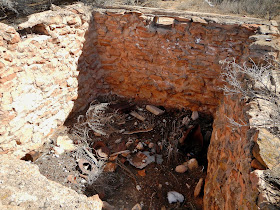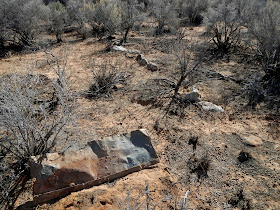During the years of 1933 to 1942, Utah had 116 total camps with an estimated 23200 men (200 per camp) ranging from the ages of 17 to 28. Many of the men were transplants from the East Coast; many stayed on to marry and raise families in Utah after the CCC camps closed down. In 1943, the camps closed down due to the intensity of World War 2; the men were needed for battle now. Two locations were turned into Japanese Internment camps; Topaz (Delta, UT) which is now a museum and Dalton Wells (Moab, UT) which is now decayed ruins indicated with a simple plaque along Highway 191. The Monticello camp (DG-157) was located in Dry Valley off Old Highway 191 which has been renamed San Juan County Road 179 aka Wilson Arch Road. It can be accessed 23.6 miles north of Monticello, across from Steen Road; or across from Wilson Arch through a new housing development.
 |
| Barracks - 1937 Courtesy of Charles Steinhauer http://www.justinmuseum.com/jkjustin2/steinhauer5.html |
 |
| Entrance Gate - 1940s Courtesy of Blue Mountain Shadows Magazine; Issue #2 - Spring 1988 http://www.bluemountainshadows.org/Vol2bluff/Enrollees.htm |
"When a CCC Camp came to Monticello in the thirties the town kids could be found hitching a ride in the back of their truck from the bottom of the hill to the top again. The CCCs brought another advantage to this small town in the form of a movie picture for free each weekend. There had been Moving Pictures before in the old Young Theater , but they were silent movies with the dialogue printed on the screen and accompanied by a player piano.
These were talking pictures. The whole community would attend including many parents trying to keep an eye on their young people. There would be a truck come to town before the shows and anyone willing to ride in a dump truck was welcome. A return truck would leave within a half hour of the end. If it was missed, there was a long walk back into town."
Why am I calling this post, "Monticello's Decaying Past"? Essentially, hardly anything remains of the CCC Camp; barely anyone knows of, or remembers, its existence which is kind of sad. It's not just Monticello's past, it's part of our American past; how we, as a nation, overcame the hardships of the Great Depression; and helped our Allies win a devastating World War (2).
 |
| The Entrance Gate in 1993. http://content.lib.utah.edu/cdm/ref/collection/USHS_ccc/id/1549 |
 |
| The Entrance Gate, March 2016 |
| Panorama View |
 |
| Satellite View |
1/10th Mile, Left Side of Road

1/10 Mile - Right Side of Road

 Also on the right side, we found this treasure, a relic of a, possibly, 1937 Pontiac. I spent a lot of time going through images online, and this year and maker seemed to be the closest.
Also on the right side, we found this treasure, a relic of a, possibly, 1937 Pontiac. I spent a lot of time going through images online, and this year and maker seemed to be the closest.
Other Artifacts Found in the Area

At 7/10ths of a mile, we ended our journey at an abandoned corral and watershed; a trail led off to the left over a rock formation, but we weren't in the mood for rock crawling the day we visited the CCC Camp.
| Panorama of Corral and Watershed |
 |
| View from the Corral. |
 Once back onto SJC 179, we headed north towards Wilson's Arch; once again, a part of history had been erased. At one time, painted onto the old pavement was "HWY 191", but the pavement was now ripped up and graded in various spots; only a memory of seeing it remains. At 4 miles (that's from the junction of 191 and 179) we came to an overpass which is in dubious condition, and overlooks Joe Wilson Canyon. However, we saw new building material nearby; the signs for oil and gas wells probably means the overpass must be repaired to take the weight of tankers coming in and out of the area.
Once back onto SJC 179, we headed north towards Wilson's Arch; once again, a part of history had been erased. At one time, painted onto the old pavement was "HWY 191", but the pavement was now ripped up and graded in various spots; only a memory of seeing it remains. At 4 miles (that's from the junction of 191 and 179) we came to an overpass which is in dubious condition, and overlooks Joe Wilson Canyon. However, we saw new building material nearby; the signs for oil and gas wells probably means the overpass must be repaired to take the weight of tankers coming in and out of the area.

 At five miles is Highway 191 again, Wilson Arch, and the Wilson Arch Community which is a housing development. So, if you begin the journey to the CCC Camp from this end, it will be located at 3.3 miles on the right hand side.
At five miles is Highway 191 again, Wilson Arch, and the Wilson Arch Community which is a housing development. So, if you begin the journey to the CCC Camp from this end, it will be located at 3.3 miles on the right hand side.There it is, another piece of Monticello, Utah's history which is being taken, by nature, into the ground. Kind of poetic if you think about it; the men at this camp reseeded and cultivated vegetation in Dry Valley; now the camp will always be a part of Dry Valley.
Mary Cokenour







































Very interesting. Looking forward to a trip out there. Thanks Mary for all the hard and interesting work you do for San Juan County
ReplyDeleteSue Morrell
Thanks Sue!!! :)
DeleteI really enjoy your pictures and the write up on the CCC camp. Thanks
ReplyDeleteThank you!
DeleteThanks Mary! We found a dam, west of Blanding, that was probably constructed by men from that camp. We appreciate your sharing the information about the camp. Best,
ReplyDeleteKelly
Wow! We need to get out there and start exploring again ourselves!
ReplyDeletePretty nice post. I just stumbled upon your weblog and wanted to say that I have really enjoyed browsing your blog posts. After all I’ll be subscribing to your feed and I hope you write again soon! gebrannte cashewkerne
ReplyDelete